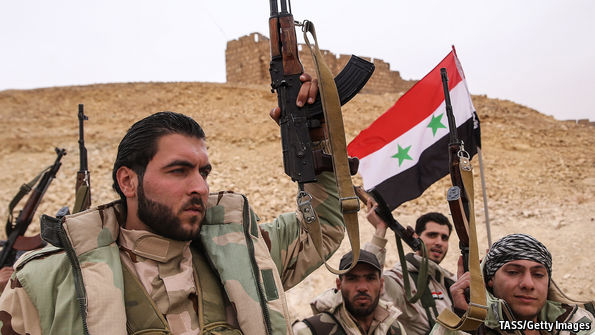All latest updates
Palmyra falls as the caliphate is pushed back in Iraq and Syria
Jihadists on the run

IT WILL provide little solace to the people of Belgium, who are mourning the death of more than 30 people at the hands of Islamic State (IS) suicide bombers in Brussels on March 22nd. But in its own heartland the IS “caliphate” is weakening markedly and losing ground. One theory might be that the jihadists are lashing out abroad because they are being pushed back at home.
In the past 14 months IS is thought to have lost about a quarter of its territory. The group’s latest setback has come in Palmyra, which the Syrian army recaptured on March 27th after weeks of fierce fighting and Russian air strikes. It is the biggest victory yet for the regime of Bashar al-Assad, Syria’s embattled president, since Russia tipped the war in his favour. Palmyra, a World Heritage site, is home to many Greco-Roman ruins, some of which were destroyed by IS. It also allows the Syrian government and its Russian ally to argue more convincingly that they are fighting jihadists, and not just mainstream Sunni rebels.
After overrunning the city in May 2015, the jihadists blew up the temples of Bel and Baal Shamin and the iconic Arch of Triumph—acts described as a war crime by the United Nations. But footage of the city shot by a Russian drone shows that at least some ancient structures remain intact. One such is the 2,000-year-old amphitheatre, where IS beheaded the city’s 81-year-old chief archaeologist, Khaled Asaad, last year. The hope is that most of the site has survived, or at least can be restored. Many more portable artefacts had been removed to Damascus before Palmyra fell a year ago.
In retaking of Palmyra the Syrian army has cut off the jihadists' supply road to their de facto capital in Raqqa (though the road to Deir Ezzor is still in their hands). They have been forced to retreat to the east, towards Iraq—but IS is faring no better there. Yazidi and tribal fighters recently captured an area in the Sinjar region, on the border with Syria, while Syrian Kurds have pushed down to take the town of Shaddadeh. The main route between Mosul and Raqqa has thus been severed, forcing IS to use the longer route via Deir Ezzor.
The big prize remains Mosul, where IS has dug in. An alliance of Kurdish Peshmerga, Shia and Sunni militias, and soldiers from the Iraqi army are slowly encircling the city. Western officials say the offensive has begun, but a big push into the city may not come until much later this year, or next. The loss of territory has affected IS’s finances. It has become harder for the group to export its oil since losing control of key crossing points on Syria’s northern border with Turkey. For months Western air strikes have targeted the jihadists’ oilfields, processing plants and physical cash holdings.
This week America killed Haji Iman, the group’s accountant and second in command—this only weeks after an American airstrike killed Abu Omar al-Shishani, its minister of war. “We are systematically eliminating ISIL’s cabinet,” says Ashton Carter, America’s secretary of defence, using America's preferred term for the jihadist group. In February an American intelligence report estimated that the number of IS fighters in Iraq and Syria had fallen by some 20%, due to death and desertion. (More than 400 jihadists are thought to have been killed in the battle for Palmyra alone.)
Some recruits are being redirected to Libya, site of another civil war. The Americans sound increasingly upbeat in their assessment of the fight against IS. But the toughest battles lie ahead. Re-taking Mosul and Raqqa will likely involve intense urban combat. Yet the bigger challenge may be figuring out who among the myriad fighting forces, split along ethnic and sectarian lines, will rule the cities once they are liberated.
Talks to end the five-year-old Syrian war, which has killed 250,000 people, have reconvened but are currently paused and are scheduled to resume next month in Geneva. The future of Mr Assad remains a sticking point. But a ceasefire between the president’s soldiers, backed by Russia, which has drawn down its forces, and rebels, backed by the West, has held for the most part. The truce has allowed more guns to be aimed at IS, which is excluded from the ceasefire—and is now on the back foot.

No comments:
Post a Comment